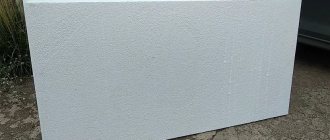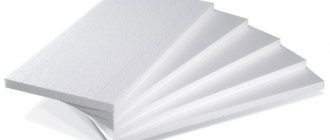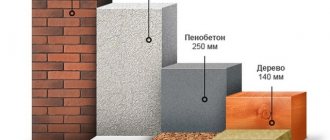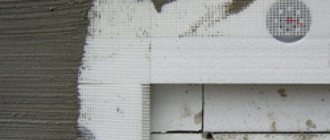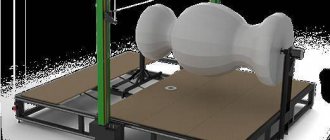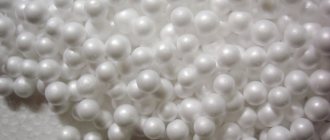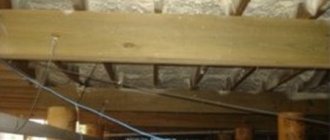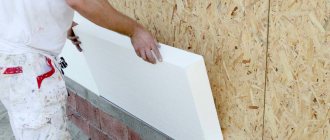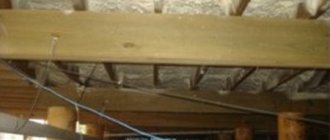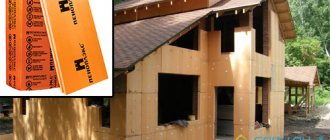Expanded polystyrene boards, colloquially referred to as polystyrene foam, are an insulating material, usually white. It is made from thermally expanded polystyrene. In appearance, the foam is presented in the form of small moisture-resistant granules; during the melting process at high temperatures, it is smelted into one whole, a slab. The sizes of the granule parts are considered to be from 5 to 15 mm. The outstanding thermal conductivity of 150 mm thick foam is achieved due to a unique structure - granules.
Each granule has a huge number of thin-walled micro-cells, which in turn increase the area of contact with air many times over. We can say with confidence that almost all polystyrene foam consists of atmospheric air, approximately 98%, in turn, this fact is their purpose - thermal insulation of buildings both outside and inside.
Everyone knows, even from physics courses, that atmospheric air is the main insulator of heat in all thermal insulation materials; it is in a normal and rarefied state, in the thickness of the material. Heat-saving, the main quality of polystyrene foam.
As mentioned earlier, polystyrene foam is almost 100% air, and this in turn determines the high ability of polystyrene foam to retain heat. This is due to the fact that air has the lowest thermal conductivity. If we look at the numbers, we will see that the thermal conductivity of polystyrene foam is expressed in the range of values from 0.037 W/mK to 0.043 W/mK. This can be compared with the thermal conductivity of air - 0.027 W/mK.
While the thermal conductivity of popular materials such as wood (0.12 W/mK), red brick (0.7 W/mK), expanded clay (0.12 W/mK) and others used for construction is much higher.
Polystyrene foam provides a high level of energy saving due to its low thermal conductivity. For example, if you build a wall of brick with a thickness of 201 cm or use a wood material with a thickness of 45 cm, then for foam plastic the thickness will be only 12 cm for a certain amount of energy savings.
Therefore, polystyrene foam is considered to be the most effective material among the few for thermal insulation of external and internal walls of a building. Residential heating and cooling costs are significantly reduced through the use of polystyrene foam in construction.
The excellent qualities of polystyrene foam boards have found their application in other types of protection, for example: polystyrene foam, which also serves to protect underground and external communications from freezing, due to which their service life increases significantly. Polystyrene foam is also used in industrial equipment (refrigerators, refrigerators) and in warehouses.
What should you buy?
The building materials market offers a huge selection of polystyrene foam boards. The high thermal conductivity of insulation boards depends on their type. For example: a sheet of polystyrene foam PSB-S 15 has a density of up to 15 kg/m3 and is 2 cm thick. For a sheet from 2 to 50 cm, the density is no more than 35 kg/m3. When comparing polystyrene foam with other similar materials, you can easily trace the dependence of the thermal conductivity of polystyrene foam boards on its thickness.
So, for example: the thermal conductivity of polystyrene foam is 50 mm, twice that of mineral wool of the same volume; in this case, the thermal conductivity of polystyrene foam with a thickness of 150 mm will generally be 6 times higher than these indicators. Basalt wool is also very inferior to polystyrene foam.
In order to apply one of the insulation methods, it is necessary to select the correct dimensions of the material. The following algorithm can be used to calculate:
- It is necessary to clarify the overall thermal resistance. This value depends on the region in which the calculation needs to be performed, namely on its climate.
- To calculate the thermal resistance of a wall, you can use the formula R=p/k, where its thickness is equal to the p value, and k is the thermal conductivity coefficient of the foam.
- From constant indicators we can conclude what resistance the insulation should have.
- The required value can be calculated using the formula p=R*k; the value of R can be found based on the previous step and the thermal conductivity coefficient.
general description
Polystyrene foam is a slab of varying thickness, consisting of foam material - polymer. The thermal conductivity of polystyrene foam is ensured by air, of which it consists of 95-98%, i.e. gas that does not allow heat to pass through.
Since polystyrene foam is basically air, it has an extremely low density and, accordingly, a low specific gravity. Also, foam plastic has very good sound insulation (thin cell partitions filled with air are a very poor conductor of sounds).
Depending on the source raw material (polymer) and manufacturing processes, it is possible to produce foam of different densities, resistance to mechanical factors, and resistance to other types of influence. In connection with the above, the choice of a certain type of foam and its use is determined.
Foam brands
If you are interested in the question of what is the best brand to buy polystyrene foam, and what is its thermal conductivity, then we will answer it for you. Below are the most popular product brands, as well as the density values and thermal conductivity of the foam.
- PSB-C15. With a thermal conductivity of 0.042 W/mK and a density of 11-15 kg/m3
- PSB-S25. With a thermal conductivity of 0.039 W/mK and a density of 15-25 kg/m3
- PSB-S35. With a thermal conductivity of 0.037 W/mK, and a density of 25-35 kg/m3
Our list is completed by polystyrene foam PSB-S5, whose thermal conductivity is 0.04 W/mK and density is 35-50 kg/m3. Having analyzed the density and thermal conductivity, we can say with confidence that density does not significantly affect the main quality of the foam, heat saving.
More on this topic on our website:
- Extruded or extruded polystyrene foam - technical characteristics of insulation Extruded polystyrene foam, being a high-tech material, can rightfully be called unique. That is why it has become so widespread in construction, plumbing production and a number of other areas...
- The well-known foam plastic, which once competed exclusively with glass wool, today itself has a lot of derivative materials, which, by the way, often give way to other modern types of insulation. By the way,…
- The first question that arises for those who decide to build their own house is what material to use for this. The choice of foundation depends on this, in turn...
- We live far from the hottest country on Earth, which means we have to heat our homes for at least most of the year. This explains...
Advantages and disadvantages of insulation
- Polyurethane foam – by far the most effective insulation.
Types of polyurethane foam
Advantages: seamless foam installation, durability, better heat and water insulation.
Disadvantages: high cost of material, instability to UV radiation.
- Expanded polystyrene (foam) – in demand for use as insulation for various types of premises.
Advantages: low thermal conductivity, low cost, ease of installation, water resistance.
Disadvantages: fragility, easy flammability, condensation.
- Extruded polystyrene foam – durable and comfortable material, if necessary, elements of the required size can be easily cut with a knife.
Advantages: very low thermal conductivity, water resistance, compressive strength, ease of installation, absence of mold and rot, ability to operate from -50⸰С to +75⸰С .
Disadvantages: much more expensive than polystyrene foam, susceptibility to organic solvents, condensation formation.
- Basalt (stone) wool – mineral wool made on a basalt base.
Advantages: resistance to the formation of fungi, sound insulation, mechanical strength, fire resistance, non-flammability.
Disadvantages: higher cost compared to analogues.
- Ecowool – insulation made from natural materials (wood fibers and minerals). Today it is used quite often.
Advantages: sound insulation, environmental friendliness, moisture resistance, affordable cost.
Disadvantages: thermal conductivity increases during operation, the need for special equipment for installation, and the possibility of shrinkage.
- Izolon – modern insulation made by foaming polyethylene. It is one of the most popular.
Advantages: low thermal conductivity, low vapor permeability, high noise insulation, ease of cutting and installation, environmental friendliness, flexibility, light weight.
Disadvantages: low strength, need for a ventilation gap.
- Penofol - insulation that meets many requirements for the quality of insulation and insulation of various premises, as well as structures, etc.
Advantages: environmental friendliness, high ability to reflect heat, high noise insulation, moisture resistance, non-flammability, ease of transportation and installation, reflection of radiation exposure.
Disadvantages: low rigidity, difficulty in fastening the material; penofol alone is not enough as thermal insulation.
What types of sinks are there for installation above the machine?
Not every sink is suitable for combination with a machine. Classic models are too bulky, given their size and unsuitable drainage device. The best option for mounting on top of a washing machine is a water lily sink with a side drain. Its low height and flat shape make it stand out among standard models. The drain of “water lilies” is located near the back of the bowl, closer to the wall, and their depth usually does not exceed 20 cm.
Water lily shells are made from a variety of materials. Sink made of polymer concrete is characterized by increased resistance to chemicals and mechanical stress. The acrylic sink attracts users with its smooth surface and impact resistance. “Water lilies” made of ceramics, plastic, glass and metal are no less in demand. Products can be of different shapes - square or rectangular, with rounded or even corners, as well as original configurations.
Sinks for installation above the washing machine are available in a wide range of shapes and sizes
First of all, you should choose a sink based on technical parameters. It is advisable that the width and length of the sink be at least 10 cm larger than the unit. This way, the electrical appliance will be protected from water getting into, for example, an unprotected control panel. Between the wall and the appliances it is necessary to leave space for hoses and pipes, which should also be taken into account when choosing a sink.
To install a sink above a narrow washing machine with a depth of no more than 37-39 cm, it is recommended to buy a sink with a width of about 50 cm. If you plan to place a unit with a depth of 50 cm under the sink, the optimal solution would be a bowl with a width of at least 60-62 cm. The following are considered the most popular models: “Quatro” (60 x 60 cm), “Uni” (60 x 50 cm), Tehnolit Kompakt (50 x 50 cm).
Another criterion for choosing a sink for installation on a washing machine is the type of drain. It is convenient when the hole is located in the back wall of the bowl or as close to it as possible, for example, in the corner under the soap dish. There are drains of different configurations:
- Round shape. The drain contains a flat siphon located directly below the drain hole, making the system less susceptible to stagnation of water and blockages. The big disadvantage is that if there is a leak, the liquid gets onto the body of the electrical equipment, which can cause a wiring malfunction or a short circuit.
- Slit-shaped. The siphon is located behind the unit, which significantly reduces the risk of water getting into the electronics, but the drain system can often become clogged due to the narrow drain hole.
For installation above a household appliance, you can choose other washbasin options, for example, a built-in or overhead bowl. These miniature and practical sink models are suitable for installation either inside or on top of any horizontal surface. A tabletop, cabinet or table is suitable for installation. To place a built-in model in them, you need to cut a hole where most of the sink will hide. An overlay bowl matched to the style can be an excellent interior decoration.
Sink and washing machine under one countertop create a single ensemble
There are also ready-made furniture sets for a washing machine with a sink, for example, “Lotos 120”. With the help of a set or a common tabletop, you can achieve the integrity of the interior, but you are unlikely to be able to save space.
Technology of thermal insulation of external walls with polystyrene foam
There are several ways to install polystyrene foam on the facade:
- On glue.
- Mechanical fastening using dowels.
- Combining method. Both glue and fasteners are used. It's more reliable.
Everyone can choose the appropriate option for themselves, but professionals recommend using the latter method. In order for the entire structure to remain securely adhere to this plan.
Preparatory work
It all starts with preparing the foundation. This stage is as important as fixing the insulation or finishing it. Here they do the following:
- If the building was previously covered with finishing, it is removed.
- Remove fasteners and hanging structures.
- The wall is cleaned of dirt, grease stains, solution build-up, and dust.
- Prime the surface. For porous materials, such as foam or gas block, choose a deep penetration primer and apply it in 2 layers. It is also desirable that the composition be antibacterial. Then the main structure will be protected from harmful microorganisms. The soil allows you to increase the adhesion of the material from which the load-bearing walls are made, and therefore securely fix the insulation to the base.
- Next, install the starting profile at the border of the base and the beginning of the wall. It will serve as a support for the foam. The profile is fixed immediately along the perimeter of the entire building. Be sure to check the horizontal position using a building level.
- Now we begin to prepare the adhesive solution. The glue should only be suitable for polystyrene foam; other brands will not work. Cooking instructions are on the package. Be sure to adhere to the proportions, otherwise the material will not stick to the wall.
Bonding boards
The finished solution must stand for some time so that all components react with each other. Next, proceed to gluing the insulation boards:
- A thin layer of the solution is applied around the perimeter of the foam board. In these places, the mixture must be rubbed into the material - this increases adhesion.
- Make 2-3 small blots in the center.
- The slabs are installed in the starting profile from the lower left corner of the house.
- The foam is pressed tightly against the wall so that the solution is evenly distributed under the sheet. If excess adhesive solution is visible, remove it with a spatula. The evenness of the installation is checked using a building level.
- Glue is also applied to the next plate and pressed tightly against both the wall and the previous sheet.
- In the second row, the vertical joints should not coincide. To do this, the foam is shifted 15–20 cm to one side.
- After all the walls are completely covered with insulation and the adhesive solution has set, begin mechanical fixation. Make holes using a hammer drill and install disc-shaped dowels.
Installation of the reinforcing layer
When the glue is completely dry, begin reinforcing the surface of the foam. For this use:
- An adhesive solution, perhaps the same one that was used to fix the slabs to the wall.
- Fiberglass mesh.
There is also a special technique for gluing the mesh:
- First of all, apply a thin layer of glue using a spatula.
- Pieces of mesh 15–20 cm wide are glued to the corners. The mesh element is laid in such a way that the two walls have identical segments. Using a clean spatula, press the fiber into the adhesive solution.
- If it doesn’t work out, add glue on top and smooth it out.
- Next, we begin to reinforce the wall.
- A mesh is placed on the corner element with an overlap of 10 cm. It is also pressed into the solution with a spatula.
- When this layer has dried, apply the finishing layer to completely hide the mesh under the glue.
Applying a decorative layer
After applying the last layer of glue, wait until it dries completely. Next, it is customary to cover the foam insulation with plaster. This may be a decorative option with an original pattern or a regular, even layer painted in a suitable color.
After all the work is completed, the house will be warm and updated at the same time. And this is a solution to two problems at once. Of course, whether to choose polystyrene foam for insulating a house or not is everyone’s business. The nuances of choice and technical characteristics listed above are quite enough to make the right choice.
The concept of thermal conductivity
In general terms, the process of thermal conduction is characterized by the transfer of thermal energy from more heated particles of a solid to less heated ones. The process will continue until thermal equilibrium occurs. In other words, until the temperatures become equal.
In relation to the building envelope (walls, floor, ceiling, roof), the heat transfer process will be determined by the time during which the temperature inside the room becomes equal to the ambient temperature.
The longer this process takes, the more comfortable the room will feel and more economical in operating costs.
Numerically, the heat transfer process is characterized by the thermal conductivity coefficient.
The physical meaning of the coefficient shows how much heat passes through a unit of surface per unit time. Those. the higher the value of this indicator, the better the heat is conducted, which means the faster the heat exchange process will occur.
Accordingly, at the design stage it is necessary to design structures whose thermal conductivity should be as low as possible.
Comparison with PSB-S-25F (0), PSB-S-25F
So, in order to compare the quality of materials, let's determine what each subspecies is needed for. PSB-S-25 is the most popular and common material, suitable for almost everything. Option PSB-S-25F (0) is a lightweight façade option. PSB-S-25F is an ideal solution for facade finishing. There is no way to compare the material in the laboratory, so it will be based on visual and tactile differences.
- Sample No. 1 (PSB-S-25) - breaks easily, grains are large (0.2-06 cm).
- Sample No. 2 (PSB-S-25F (0)) is a lightweight version of the first sample. The break occurs without much effort, but it is felt that the material is denser than the previous sample. The grains are medium in size (0.1-0.2 cm).
- Sample No. 3 (PSB-S-25F) is an option that is intended exclusively for the facade, only it is used in high-quality SIP panels. The sample is denser than the previous two, breaks more easily, and has small grains.
As you can see, no matter what anyone says, all 3 brands are even visually and torn apart.
Why is thermal insulation needed?
The relevance of thermal insulation is as follows:
Keeps you warm in winter and cool in summer.
Heat loss through the walls of a typical multi-storey residential building is 30-40%. To reduce heat loss, special thermal insulation materials are needed. The use of electric heaters in winter contributes to additional energy costs. It is more profitable to compensate for these costs by using high-quality thermal insulation material, which ensures heat retention in winter and coolness in the summer heat. At the same time, the cost of cooling the room with air conditioning will also be minimized.
Increasing the durability of building structures.
In the case of industrial buildings using a metal frame, insulation helps protect the metal surface from corrosion, which is the most detrimental defect for this type of structure. And the service life of a brick building is determined by the number of freeze/thaw cycles. The impact of these cycles is perceived by the insulation, because the dew point is located in the thermal insulation material, and not in the wall material. Such insulation allows you to increase the service life of the building many times.
Protection against increasing noise levels is achieved by using such noise-absorbing materials (thick mattresses, sound-reflecting wall panels).
Increasing the usable area of buildings.
The use of a thermal insulation system makes it possible to reduce the thickness of external walls, while increasing the internal area of the building.
